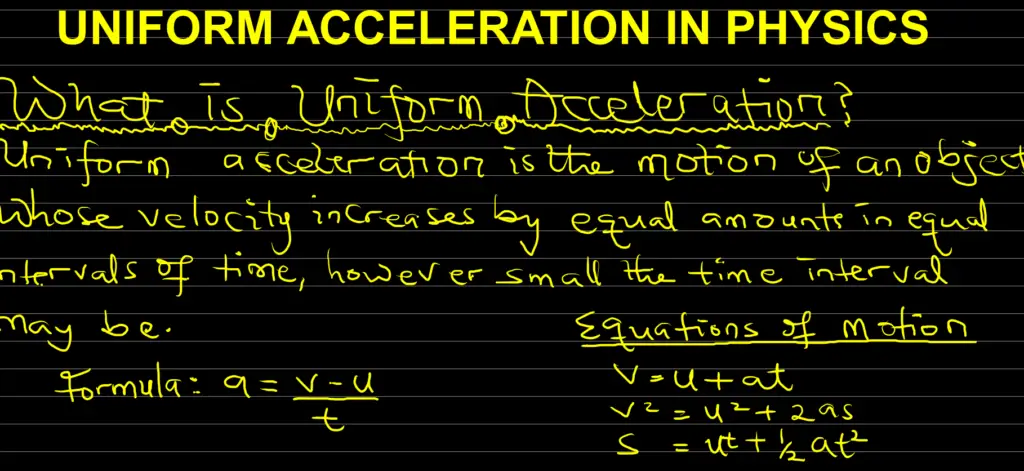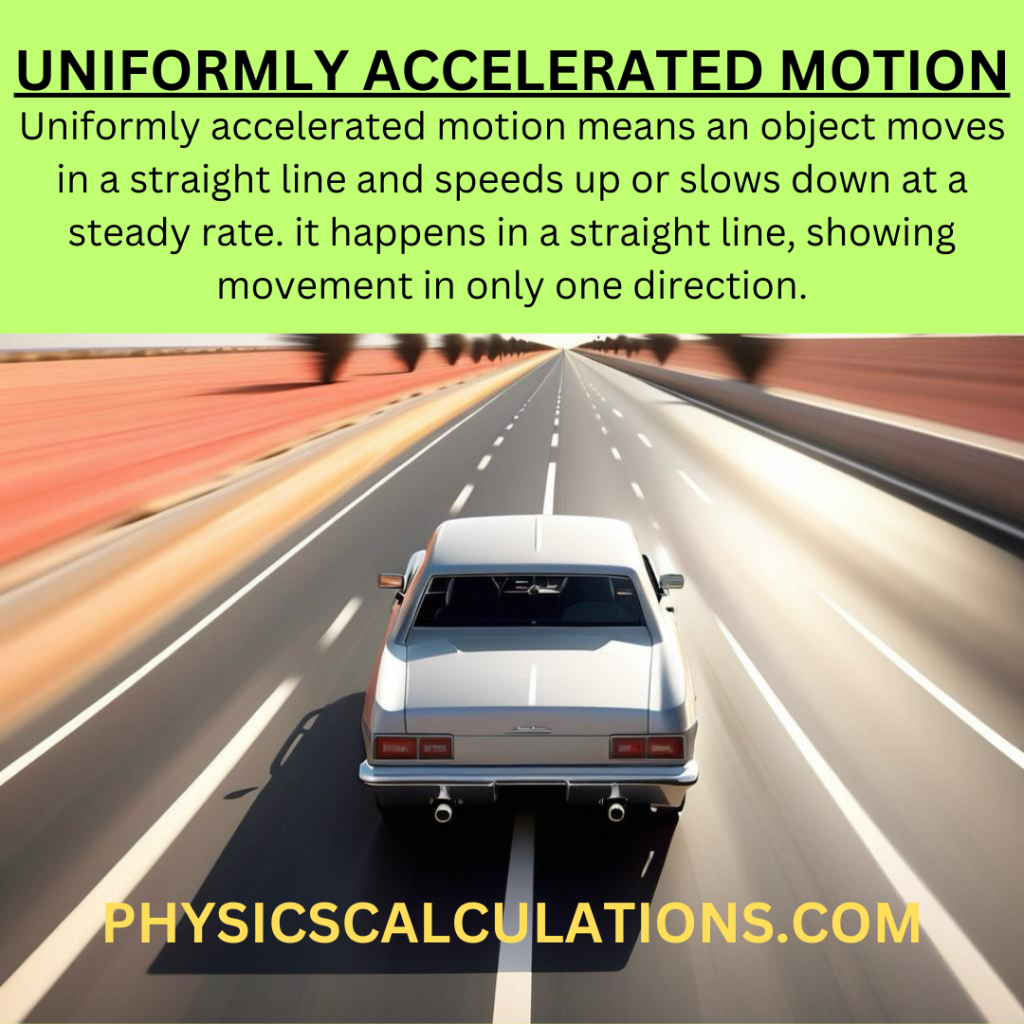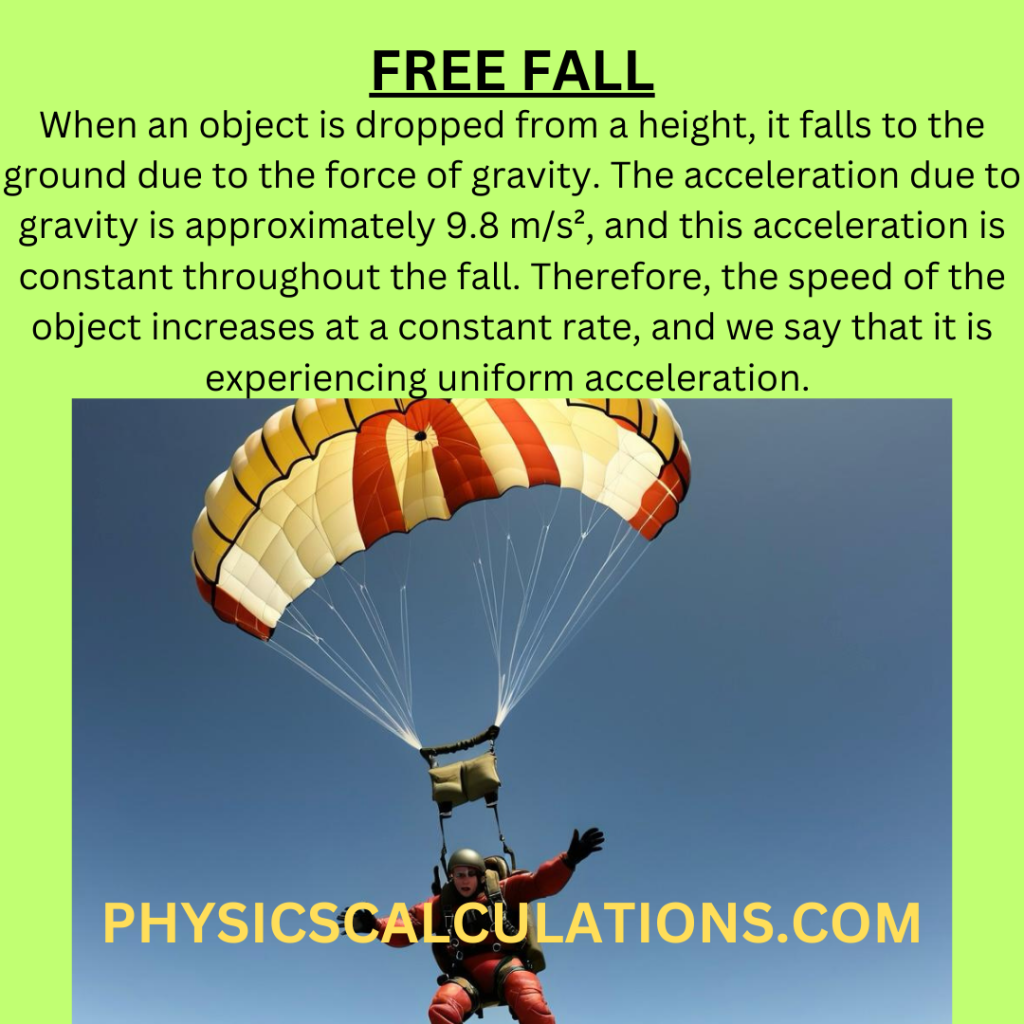1. What is Uniform Acceleration?
Definition: Uniform acceleration is the motion of an object whose velocity increases by equal amounts in equal intervals of time, however small the time interval may be. Uniform acceleration is the constant rate of change of velocity over time, where an object’s speed increases or decreases by the same amount in each equal interval of time. An example of uniform acceleration is the motion of an object falling freely under gravity. The uniform acceleration formula is a=(v-u)/t. In this case, a represents the acceleration, v is the final velocity, u is the initial velocity, and t is the time. The s.i unit of uniform acceleration is meters per second square (m/s2)
Uniform acceleration describes the motion of an object with a constant rate of change in its velocity. This type of motion occurs when you apply a constant force on an object, which causes its speed to increase or decrease at a steady rate.
2. Understanding Uniform Acceleration
The knowledge of the basic concept of acceleration will improve our understanding of uniform acceleration. Acceleration is defined as the rate of change of an object’s velocity with respect to time. In other words, it is the change in speed or direction of an object over time. The s.i unit of acceleration is also meters per second squared (m/s²). Below is a picture defining constant acceleration and listing equations of motion.

Uniform acceleration occurs when an object experiences a constant force, causing it to change its speed at a steady rate. The rate of change of velocity is constant in uniform acceleration, and the object’s speed increases or decreases by the same amount in each unit of time.
3. Uniformly Accelerated Motion In A Plane
Uniformly Accelerated Motion in a plane refers to the kinematic behaviour of an object experiencing constant acceleration while moving along a two-dimensional path (plane). This motion is characterized by the simultaneous change in both speed and direction over time, with the acceleration remaining constant. In a plane, the object’s position is described by two coordinates, typically represented as horizontal (x) and vertical (y) components.
Mathematically, the equations governing uniformly accelerated motion in a plane are extensions of those for one-dimensional motion. The object’s position, velocity, and acceleration in both the x and y directions are determined by corresponding equations incorporating time. These equations often involve the initial conditions of the object, such as its initial position, velocity, and the angle of its trajectory.
Uniformly accelerated motion in a plane enables the prediction and analysis of complex motion scenarios, such as projectile motion. Additionally, this type of motion finds applications in different fields, ranging from ballistics and sports to aerospace engineering. Therefore, the principles of uniformly accelerated motion in a plane provide a fundamental framework for modeling and solving problems related to the motion of objects in two-dimensional space.
3.1 Explanation of Uniformly Accelerated Motion
Uniformly accelerated motion means an object moves in a straight line and speeds up or slows down at a steady rate. In this type of motion, the acceleration remains constant, and there is no change in direction. Unlike motion at a constant speed in a straight line, where there is no acceleration, in a uniformly accelerated motion, the speed keeps changing because of the acceleration. (Note: Constant speed in a circle has acceleration).
The key features of uniformly accelerated motion help us recognize if we are dealing with this type of motion: it happens in a straight line, showing movement in only one direction. The main difference from motion at a constant speed is that there is always acceleration present. As a result, the speed of the object keeps changing continuously; it either increases or decreases due to the effect of that acceleration. Therefore, there is always an initial speed (u) and a final speed (v) involved in situations of uniformly accelerated motion.

If both acceleration and speed have the same direction, the object speeds up every second. But if their directions are opposite (like positive and negative acceleration), the object slows down every second until it stops completely.
4. Rectilinear Acceleration
Definition: The term Rectilinear Acceleration means the rate of increase of velocity along a straight-line path in a unit time. An object can accelerate or decelerate when its velocity continues to change. Deceleration is the decreasing rate of change velocity with time. The other names for DECELERATION are RETARDATION or NEGATIVE DECELERATION.
Acceleration or Decelaration (a) = Change in Velocity / Time taken for the change
a = ( Final Velocity (V) – Initial Velocity (U) ) / ( Final time (t2) – Initial time (t1) )
a = (V – U) / (t2 – t1)
5. Equations of Uniformly Accelerated Motion
The three equations of motion for a body traveling along a straight line with uniform acceleration are as follows:
- v = u + at
- s = ut + (1/2)at2
- v2 = u2 + 2as
Where
v = Final Velocity, u = Initial Velocity, a = Acceleration, t = Time and s = Distance covered
6. Examples of Uniform Acceleration
We observe Uniform Acceleration in various situations of our daily lives. Some common examples include:
a. Objects in Free Fall
When you drop an object from a height (say sky), it will fall to the ground due to the force of gravity. The acceleration due to gravity is approximately 9.8 m/s², and this acceleration is constant throughout the fall. Therefore, the speed of the object increases at a constant rate, and we say that it is experiencing uniform acceleration. Below is a picture of a man (parachute dropping from the sky).

b. Moving Vehicles
When a vehicle accelerates from rest, its speed increases at a constant rate until it reaches its maximum velocity. Similarly, when the vehicle decelerates, its speed decreases at a constant rate until it stops. Both these scenarios are examples of uniform acceleration. Imagine starting your car and pressing the gas pedal, it is speed will increase (accelerate) and the mileage will continue to adjust itself. However, the moment you remove your leg from the gas pedal and press the brake pedal, its speed will continue to reduce (decelerate) until it stops.
c. Roller Coasters
Roller coasters are designed to provide an exciting and thrilling experience to its riders. They use the concept of uniform acceleration to create different sensations during the ride. For example, when the roller coaster moves uphill, it slows down due to gravity, and the acceleration becomes negative. Similarly, when the roller coaster moves downhill, it gains speed due to gravity, and the acceleration becomes positive again.

7. How to Calculate Uniform Acceleration?
We can easily calculate Uniform Acceleration by applying a simple formula below:
a = (v – u) / t
Where “a” represents the acceleration, “v” is the final velocity, “u” is the initial velocity, and “t” is the time taken.
It is important to note that this formula only works for uniform acceleration, where the rate of change of velocity is constant.
8. Characteristics of Uniformly Accelerated Motion
- Constant Acceleration: Motion involves a consistent rate of change in velocity.
- Equal Intervals: Equal time intervals result in equal changes in velocity.
- Linear Relationship: Velocity changes linearly with time.
- Constant Force: Implies a constant force acting on the object.
- Squared Dependence: Displacement is proportional to the square of the time.
- Initial Conditions: Specific initial velocity and position are known.
9. Applications of Uniform Acceleration
Uniform acceleration has various applications in different fields, including:
a. Gravity
Uniform acceleration due to gravity helps our understanding of the universe. The acceleration due to gravity on the Earth’s surface is approximately 9.8 m/s², and it affects everything around us. It is responsible for keeping the planets in orbit around the sun and for creating tides in the oceans. Below is a video showing an example of gravity where apples fall from a tree to the ground.
b. Projectile Motion
Projectile motion is the motion of an object through the air under the influence of gravity. It is a classic example of uniform acceleration. When an object is thrown into the air, it experiences a constant acceleration due to gravity, causing its speed to increase until it reaches its maximum height, and then it decelerates until it comes back to the ground.
c. Newton’s Laws of Motion
Newton’s laws of motion help us in understanding the relationship between force, mass, and acceleration. Uniform acceleration is an important concept in these laws, and it helps us understand the behaviour of objects in different scenarios. For example, Newton’s second law states that the acceleration of an object is directly proportional to the force applied to it and inversely proportional to its mass (F=ma).
10. Importance of Uniform Acceleration
Uniform acceleration is applicable in various fields like scientific research, engineering, and everyday life. Some of its applications are:
a. Scientific Research
Uniform acceleration plays a vital role in scientific research, especially in the fields of physics and astronomy. It helps us understand the behavior of objects in different environments, such as in outer space, where the force of gravity is weak.
b. Engineering and Design
Engineers and designers use the concept of uniform acceleration to create different machines and systems, such as rockets and aeroplanes. Therefore, they need to understand the behavior of these objects under different conditions, including acceleration and deceleration.
c. Everyday Life
Uniform acceleration is present in many of our daily activities, such as driving a car, riding a bike, or throwing a ball. Understanding the concept of uniform acceleration helps us predict the behavior of objects in different situations and make informed decisions.
11. Common Misconceptions about Uniform Acceleration
There are several misconceptions about uniform acceleration that need to be addressed. These include:
a. Uniform Acceleration is Constant Speed
Uniform acceleration is not the same as constant speed. Even if an object is moving at a constant speed, it is not experiencing uniform acceleration unless its velocity is changing at a constant rate.
b. Uniform Acceleration Only Occurs in Straight Lines
Uniform acceleration can occur in any direction, whether it is straight or curved. For example, a car moving around a circular track at a constant speed is experiencing uniform acceleration.
c. Uniform Acceleration is Always Positive
Uniform acceleration can be positive or negative, depending on the direction of the acceleration. For example, an object moving upward is experiencing negative acceleration due to gravity, while an object moving downward is experiencing positive acceleration.
12. Non-Uniform Acceleration
Non-uniform acceleration refers to the motion of an object experiencing a changing rate of acceleration over time. In contrast to uniform acceleration, where velocity varies uniformly in equal time intervals, non-uniform acceleration involves irregular changes in velocity, resulting in a non-constant acceleration. The acceleration of the object is not consistent, varying either in magnitude or direction as time progresses.
This type of motion can be caused by forces that are not constant, such as varying external influences or internal resistive forces like friction. As a consequence, the velocity-time graph for non-uniform acceleration appears curved rather than a straight line. Analyzing non-uniform acceleration often involves calculus, as instantaneous acceleration at any given moment may be required to understand the dynamic changes in motion. Unlike uniform acceleration problems, where equations of motion are straightforward, solving non-uniform acceleration scenarios may demand more complex mathematical approaches. Understanding non-uniform acceleration is key in describing the diverse and dynamic nature of real-world motion scenarios where external influences fluctuate, leading to intricate changes in an object’s acceleration over time.
13. Types of Acceleration Based on Increase or Decrease
Acceleration, the rate of change of velocity, can be categorized based on whether it involves an increase or decrease in speed.
- Positive acceleration occurs when an object’s velocity rises over time, indicating a speeding up or forward motion. This can result from an applied force in the direction of motion. On the other hand,
- Negative acceleration, often referred to as deceleration or retardation, signifies a reduction in velocity, indicating a slowing down or backward motion. Negative acceleration arises when a force acts opposite to the direction of motion, leading to a decrease in speed.
Positive and negative accelerations are key concepts in understanding various dynamic scenarios, such as a car accelerating on a straight road (positive acceleration) or coming to a stop (negative acceleration). These types of acceleration play a pivotal role in physics, engineering, and everyday experiences, providing a fundamental framework for describing and analyzing the different motions observed in the physical world. Understanding these concepts helps to model and predict the behaviour of objects in response to different forces, facilitating the design and analysis of various systems and technologies.
14. Solved Problems
Here is a solved problem to help you understand how to calculate uniform acceleration:
14.1 Problem
A particle accelerates uniformly from rest at 6.0 m/s2 for 8 seconds and then decelerates uniformly to rest in the next 5 seconds. Determine the magnitude of the deceleration.
Answer
The magnitude of the deceleration is 9.6 ms-2.
Explanation
We are calculating the particle’s deceleration. Thus,
Data:
Initial velocity, u = 0
acceleration, a = 6 m/s2
time, t = 8 s
Unknown:
Final velocity, v = ?
Formula:
v = u + at
Solution
v= 0 + 6 x 8 = 48 m/s
Now, the particle decelerates to rest from a velocity of 48 m/s. Therefore, we can ccalculate the deceleration in this way:
u = 48 m/s, v = 0, t = 5 s, deceleration (a) = ?
Therefore, from v = u +at
0 = 48 + a x 5
making a subject of the formula, we will have
a = – 48/5 = – 9.6 m/s2 [The negative sign shows that we are dealing with deceleration]
Therefore, the magnitude of the deceleration is 9.6 meters per second square (m/s2)
15. Conclusion
Uniform acceleration is a fundamental concept in physics that helps us understand the motion of objects under different conditions. It is present in various fields, including scientific research, engineering, and everyday life. Understanding the concept of uniform acceleration and its applications can help us make informed decisions and improve our understanding of the world around us.
16. Frequently Asked Questions (FAQs):
- What is uniform acceleration?
Uniform acceleration is the motion of an object with a constant rate of change in its velocity, caused by a constant force.
- How do you calculate uniform acceleration?
Uniform acceleration can be calculated using the formula: a = (v – u) / t, where “a” represents the acceleration, “v” is the final velocity, “u” is the initial velocity, and “t” is the time taken.
- What are some examples of uniform acceleration?
Examples of uniform acceleration include free fall due to gravity, projectile motion, and circular motion.
- How is uniform acceleration different from constant speed?
Uniform acceleration is not the same as constant speed. Even if an object is moving at a constant speed, it is not experiencing uniform acceleration unless its velocity is changing at a constant rate.
- Why is uniform acceleration important?
Uniform acceleration is important in various fields, including scientific research, engineering, and everyday life. Understanding the concept of uniform acceleration and its applications can help us make informed decisions and improve our understanding of the world around us.
You may also like to read:
How to Calculate Average Speed in Physics